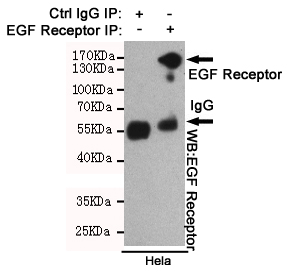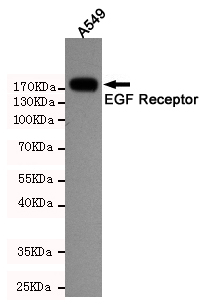-
Product Name
Anti-EGFR (1A11) Mouse antibody
- Documents
-
Description
EGFR (1A11) Mouse monoclonal antibody
-
Tested applications
WB, IP
-
Species reactivity
Human
-
Alternative names
Avian erythroblastic leukemia viral (v erb b) oncogene homolog;Cell growth inhibiting protein 40;Cell proliferation inducing protein 61;EGF R;EGFR;EGFR_HUMAN;Epidermal growth factor receptor (avian erythroblastic leukemia viral (v erb b) oncogene homolog) antibody
-
Isotype
Mouse IgG1
-
Preparation
Antigen: Purified recombinant human EGFR protein fragments expressed in E.coli.
-
Clonality
Monoclonal
-
Formulation
Purified mouse monoclonal in PBS(pH 7.4) containing with 0.02% sodium azide 0.1%BSA and 50% glycerol.
-
Storage instructions
Store at 4°C short term. Store at -20°C long term. Avoid freeze / thaw cycle.
-
Applications
WB: 1/2000
-
Validations

Immunoprecipitation analysis of Hela cell lysates using EGFR mouse mAb.

Western blot detection of EGFR in A549 cell lysates using EGFR mouse mAb(dilution 1:2000).Predicted band size:134 Kda.Observed band size:175KDa.
-
Background
Swiss-Prot Acc.P00533.Receptor tyrosine kinase binding ligands of the EGF family and activating several signaling cascades to convert extracellular cues into appropriate cellular responses. Known ligands include EGF, TGFA/TGF-alpha, amphiregulin, epigen/EPGN, BTC/betacellulin, epiregulin/EREG and HBEGF/heparin-binding EGF. Ligand binding triggers receptor homo- and/or heterodimerization and autophosphorylation on key cytoplasmic residues. The phosphorylated receptor recruits adapter proteins like GRB2 which in turn activates complex downstream signaling cascades. Activates at least 4 major downstream signaling cascades including the RAS-RAF-MEK-ERK, PI3 kinase-AKT, PLCgamma-PKC and STATs modules. May also activate the NF-kappa-B signaling cascade. Also directly phosphorylates other proteins like RGS16, activating its GTPase activity and probably coupling the EGF receptor signaling to the G protein-coupled receptor signaling. Also phosphorylates MUC1 and increases its interaction with SRC and CTNNB1/beta-catenin.
Related Products / Services
Please note: All products are "FOR RESEARCH USE ONLY AND ARE NOT INTENDED FOR DIAGNOSTIC OR THERAPEUTIC USE"
